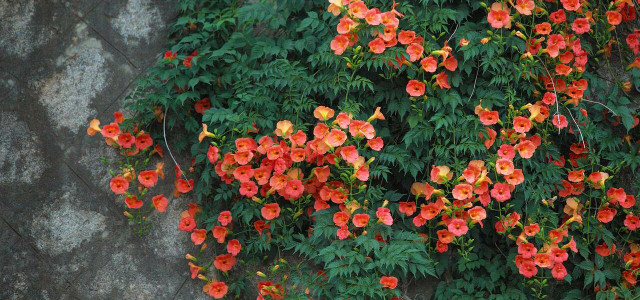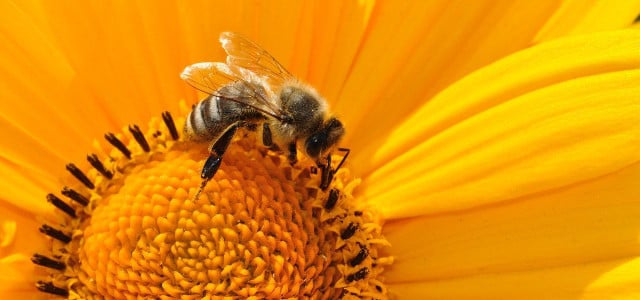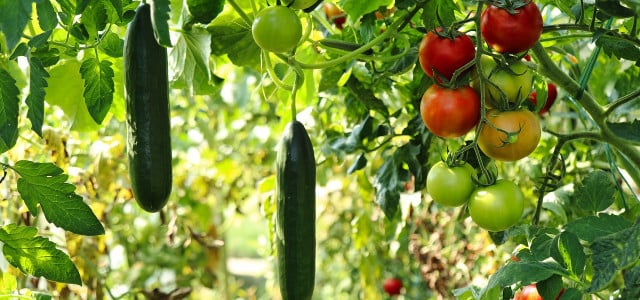Looking to put that bare fence or wall to use? These non-invasive climbing plants can expand your garden space vertically while benefiting the environment.
Climbing plants are a fantastic way to add height to your garden and take advantage of vertical space. While many can function as plants for ground cover when flat, growing them vertically increases your available garden space and also maximizes the amount of sunlight that the climbers can take advantage of. Strategically placed trellises can also create shade or privacy for a backyard while foliage adhered to your home can also function as insulation from heat or cold. Many climbing plants can also help with native gardening for wildlife by providing a habitat or food source for insects or birds. All 25 plants below are non-invasive and thirteen of them are North American natives.
Climbing Plants for Foliage
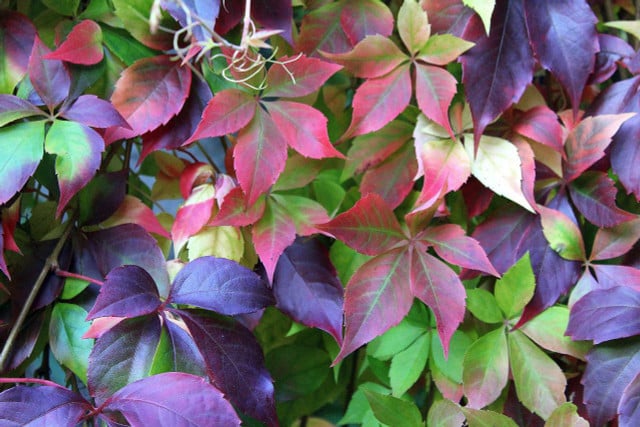
Without conspicuous flowers, these expansive woody vines wow with their foliage instead. Because of their size, grow with a strong trellising system and plenty of space to expand. With the exception of Boston ivy, all these plants are natives.
1. Virginia Creeper: A vigorous vine for all light and soil conditions with attractive red autumn colors. Vines will adhesively grow on flat surfaces, but will eventually become heavy enough to damage to weak supports. Grow on masonry, brick, or sturdy support systems. The inconspicuous flowers and berries provide food for pollinators and birds, but are toxic to humans.
2. Dutchman’s Pipe: The Dutchman’s Pipe is grown for its attractive foliage, but is named for the unusual flowers. These modest flowers resemble pipes and attract flies and beetles with their unpleasant smell. Grow in a spot away from your house in full sun.
3. Grapes: Although most varieties are from Europe and Asia, the USA has its own share of native grape varieties such as the wild Riverbank or Fox grapes as well as cultivated Concord, Scuppernong, or Muscadine grapes. Although you can grow them in shade for foliage, fruiting grapes need full sun and plenty of water. Grow with ample weight support for the woody stems and fruit.
4. Boston Ivy: Related to Virginia Creeper, Boston Ivy can thrive in various light or soil conditions, though full sun will stimulate more vibrant autumn colors. Like Virginia Creeper, it will also spread across flat surfaces adhesively and is often grown on brick or masonry. Despite its name, Boston Ivy originates from Asia, but is not usually considered invasive and has difficulty surviving in the wild.
Native Flowering Vines
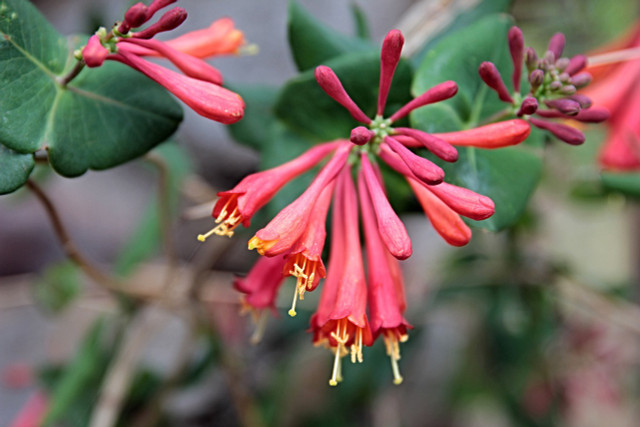


These native climbing plants are not only visually stunning, but they are favorites for pollinators as well.
5. Trumpet Vine: Featured in the article image, trumpet vine is named for its vivid orange flowers that attract pollinators. The adhesive vines will grow along flat surfaces such as walls, but often need some added support since they grow heavy. Plant in full sun with plenty of space and prune regularly to curb its rapid growth.
6. Trumpet Honeysuckle: Also known as coral honeysuckle, this native variety is a favorite of pollinators. It grows best in full sun and should be pruned after flowering as the vines tend to overgrow on top of each other.
7. Crossvine: A mild-mannered relative to the Trumpet Vine, the crossvine also blooms bright orange flowers, but grows less aggressively. Grow in full sun for optimum blooming.
8. American Wisteria: A non-invasive relative to the typical Asian wisteria, this giant woody vine produces profuse violet flowers to attract pollinators. Grow in full sun with a strong support, plenty of space, and prune to stimulate continued blooming.
9. Carolina Jessamin: The state flower of South Carolina, the Carolina Jessamin is known for fragrant yellow flowers that bloom best in full sun. It is a modest grower that doesn’t tolerate extreme cold, so is best grown in the southern half of the USA.
10. Purple Passionflower: Not only is this a native North American climbing plant, but it produces flowers and edible fruit just like its tropical relatives. It favors full sun and thrives in the Southern USA; in areas of frost, its branches will die back, but roots will survive if properly covered.
Annual Climbing Vegetables
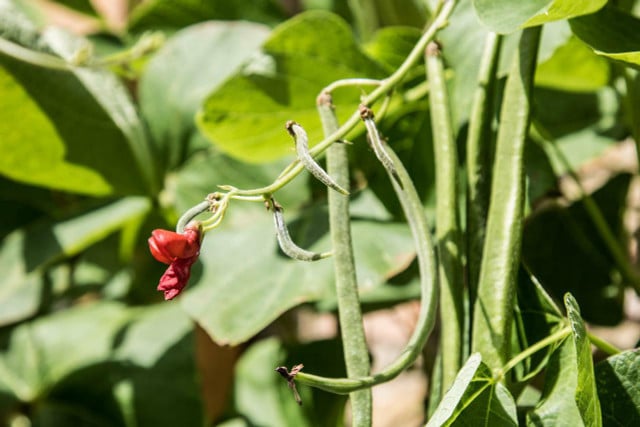


These vegetables are all light climbers that attract pollinators with spring blooms and then produce vegetables later in the season. As annuals they are no-commitment climbing plants that will grow for only one year and die back in the winter. All are native except for peas, and grow in full sun with adequate water and compost for optimal harvest.
11. Beans: Beans have several different varieties to choose from such as low bush beans, pole beans requiring some light support, or scarlet runner beans, which produce vibrant red flowers.
12. Cucumbers: Despite the size of the vegetables, cucumbers do well on vertical surfaces provided they receive ample support.
13. Squash: Including varieties such as summer squash, winter squash, and pumpkins, these vines grow best on flatter surfaces or with strong vertical support due to the heaviness of the veggies. If you aren’t interested in harvesting squash, then the flowers are also edible and can be fried for a treat.
14. Zucchini: A relative of the squash, zucchini grows well on trellis systems with enough support for their weight.
15. Peas: Like beans, peas are light climbers can can grow vertically without putting on too much weight. Ornamental sweet peas can also be grown for their colorful flowers and pleasant aroma rather than the pea pods. Though non-native to the USA, annual peas die back in winter and are thus non-invasive. Avoid perennial or everlasting pea varieties since these regrow each year and can become invasive.
Non-Native Climbing Plants to Consider
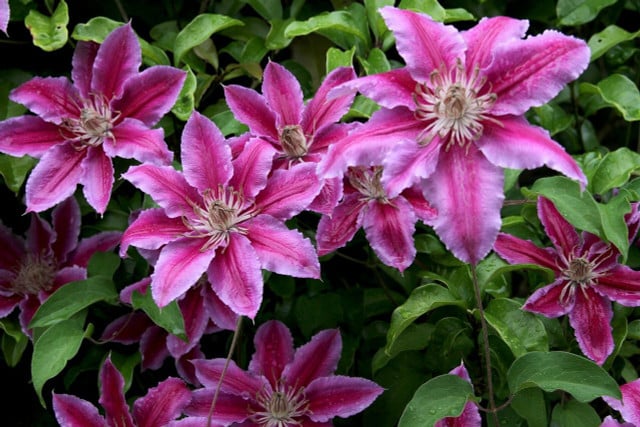


Although these climbing plants are not native to the USA, they do not spread readily via seeds or roots and are thus are not considered invasive.
16. Clematis: Known for its large purple or pink flowers, clematis is a great choice for a light, non aggressive bloomer that needs only a small wire trellis for support. Grow in full sun for the best blooms.
17. Climbing Rose: Climbing roses can add a romantic flush of color to any garden in full or partial sun. This is not a low maintenance plant however: since the climbing rose lacks vines, the young branches must be carefully trained up a support structure to avoid sprawling.
18. Climbing Hydrangea: This variety has the same puffy inflorescences as the regular hydrangea in climbing form. It has adhesive vines to grow along flat surfaces, but is also incredibly bulky when at full size, so strong trellising is recommended. Grow in partial sun.
19. Hardy Kiwi: While the commercially grown kiwifruit is tropical, the hardy kiwi can grow all over the USA and benefits from some winter frost. Vines are woody, vigorous, and should be trained up on a strong support structure. Because both male and female plants are needed to produce fruit, the hardy kiwi is often grown ornamentally. The Arctic Beauty variety even has vibrant pink variegated foliage.
20. Hops: Interested in growing hops at home? Not only can you brew some beer, but also support pollinators. Hops in an uninstructive climber that dies back in the winter and needs light vertical support for when it re-sprouts in the spring. Though it does well in shade, it requires full sun in order to produce plenty of hops for beer. Commercial hops derive from both native North American and European varieties.
Tropical Climbing Plants
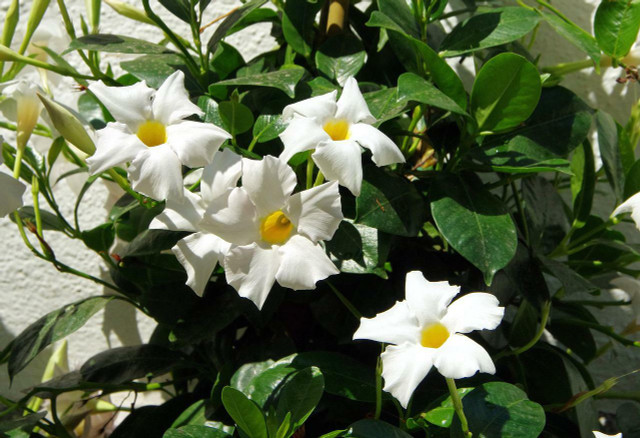


As tropical climbers, these plants are all non-native but also non-invasive since they cannot survive winter frost. Grow as outdoor perennials along the Gulf Coast and California, or as annuals in northern states. All can be brought indoors to overwinter and make excellent container plants for your balcony or indoor hanging plants.
21. Mandevilla: Known for its large flowers, Mandevilla grows best in full sun with light support. Although it does have some native US varieties, most commercial cultivars are Brazilian in origin. It fares well with indoor overwintering, provided that you trim it down to a manageable size.
22. Moonflower: A relative to the morning glory, moonflowers grow large white blooms and heart shaped foliage. Plant in full sun and prune regularly for a bushier shape. Since Moonflower grows rapidly, it is often treated as an annual in northern states.
23. Black Eyed Susan Vine: Featuring bright orange flowers and vigorous vines that might need trimming to be brought back inside. In northern states, it is often grown as an outdoor annual since it grows rapidly in full sun. Since it is known to be invasive in tropical areas, avoid planting if you live in areas without winter frost.
24. Sweet Potato Vine: An ornamental variety grown for its colorful foliage, the sweet potato vine favors full or partial sun. Due to its quick growing habit, sweet potato vine is often planted outdoors as a summer annual and its tubers dug up for overwintering.
25. Star Jasmine: Grown for its white flowers and pleasant fragrance, star jasmine is a hit with pollinators. It grows slowly and lacks vines, so the wandering stems should be trained onto a trellis or pruned for a more bushy shape. With petite growth and partial shade tolerance, Star Jasmine makes an ideal container plant for indoor overwintering.
Climbing Plants You Should Avoid
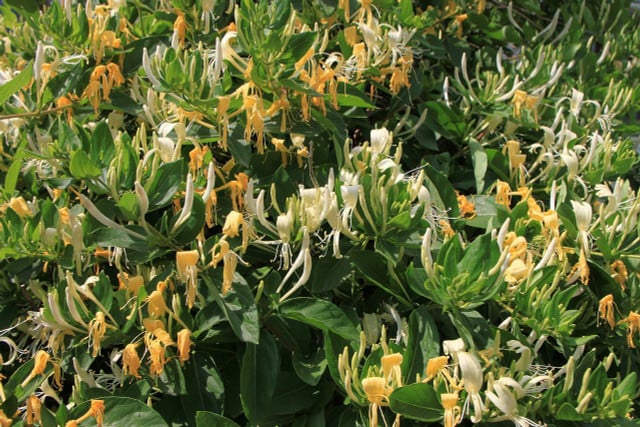


Climbing plants already have a tendency to cover other plants in search of light, but these invasive plants are especially damaging because they can multiply and completely out-compete native plants.
- Japanese Honeysuckle: Though visually similar to the American variety, Japanese Honeysuckle can quickly spread by seed to cover fields and forests.
- English Ivy: Although it provides a dignified aesthetic to European architecture, this vine spreads invasively in North America and can quickly overgrow on native plants.
- Morning Glory: Though annual, morning glory readily spreads via seeds in the environment.
- Chocolate Vine: Grown for its attractive foliage, Chocolate Vine can form dense woody matts that are nearly impossible to remove without herbicides.
Read more:
- Japanese Knotweed: Identification & Control
- Companion Planting: A Beginners Guide
- 10 Flowering Vegetables You Can Grow in Your Garden
Do you like this post?






